How Dylan’s Achieved Greater Engagement, Loyalty & Profits
BuyerGenomics’ CEO Mike Ferranti was joined by Dylan’s Candy Bar’s Kevin Cohen at the NEMOA (National Etailing and Mailing Organization’s) directXchange Fall Conference in Chicago, IL. At the event, they presented a Case Study detailing Dylan’s success in partnering with BuyerGenomics. Prior to engaging BuyerGenomics, Dylan’s Candy Bar was experiencing many of the problems plaguing the retail industry today — including the struggle to consistently acquire and retain high-value customers — also known as Most Valuable Buyers (or MVBs). Dylan’s improved their new customer acquisition substantially by leveraging Customer Intelligence and CRM insights through BuyerGenomics Predictive Marketing Automation (PMA) platform. Dylan’s succeeded where other retailers have not, by acquiring net new customers at scale, with higher potential value than their average customer previously.Sweet Results
Ferranti and Cohen co-presented this Case Study at NEMOA, detailing the success in acquiring high-value buyers through a unique combination of cloud computing, machine learning, and predictive marketing – in large part enabled by Dylan’s thoughtful implementation of BuyerGenomics. The end results were some of the “sweetest” Dylan’s had achieved to that point.
Executive Summary
- In this Case Study, we’ll cover how Dylan’s implemented BuyerGenomics’ Predictive Marketing Automation (PMA) platform to solve problems that traditionally takes months, in a matter of days. As a result, Dylan’s time, energy, and investment was focused on taking action and generating conversions.
- Mike Ferranti and Kevin Cohen discussed and illustrated how the Best Customers You Have Today are actually the root of The Answer to Acquiring Net New Customers that not only spend more, but more often than the rest.
- Cohen elaborated on specifically how Dylan’s developed a dramatically deeper view and understanding of the customer, developed new unique cohorts that explained the heterogeneity that existed in their customer base, and identified in high resolution who their Most Valuable Buyers really were — which then drove the target definition of for net new customers.
Table of Contents
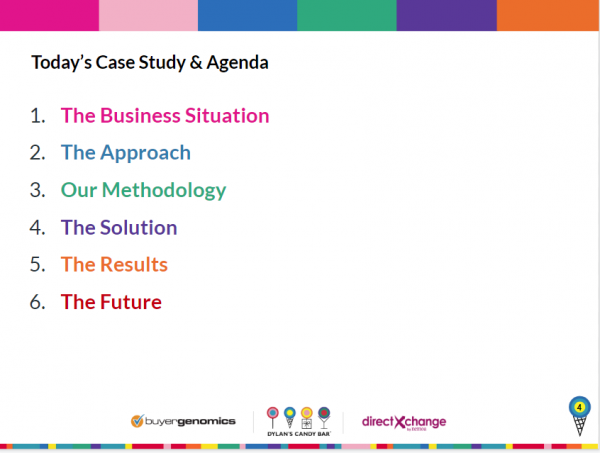 The presentation began with Mike introducing Kevin Cohen to the stage before a packed audience, and laying out the 6 core phases of the process, from the problem definition all the way up to the solution and ensuing results.
The presentation began with Mike introducing Kevin Cohen to the stage before a packed audience, and laying out the 6 core phases of the process, from the problem definition all the way up to the solution and ensuing results.
- The Business Situation – While Dylan’s was generating high consumer traffic, they lacked the high-value, repeat buyers that would drive their business.
- The Approach – BuyerGenomics designed an intelligent, actionable data-driven campaign that specifically targeted net new customers who spent most like the best of their current base.
- Our Methodology – Within just three weeks, Dylan’s was able to generate a clear view of its customer base and implement a \”Buy-A-Like\” acquisition campaign.
- The Solution – A multi-step omni-channel campaign was used to reach the right customers, at the right place, at the right time – driving engagement and understanding the motivating factors that led customers to purchase.
- The Results – Dylan’s experienced massive increases in new valuable customer acquisition, conversion rate, average spend, and repeat purchase rate.
- The Future – Dylan’s continues to grow as a vibrant, dynamic business, and BuyerGenomics continues to support Dylan’s growing high-value customer acquisition campaign.
Did Dylan’s Have a Problem Worth Solving?
 There is an old saying, “Spend 90 percent of your time defining the problem, and you only need 10 percent to solve it.”
Therefore, the first question Dylan’s and BuyerGenomics asked was whether there was a problem worth investing in solving. Ultimately, they decided that based on the high cost of acquisition, it was deemed a requirement that the customer they acquired be of higher value – particularly given the historic norm of acquiring “one and done” or one-time buyers.
Takeaway: If you’re trying to solve the wrong problem, don’t expect much of an outcome. If you’re targeting just “conversions” – don’t expect much in the way of “high value relationships.”
There is an old saying, “Spend 90 percent of your time defining the problem, and you only need 10 percent to solve it.”
Therefore, the first question Dylan’s and BuyerGenomics asked was whether there was a problem worth investing in solving. Ultimately, they decided that based on the high cost of acquisition, it was deemed a requirement that the customer they acquired be of higher value – particularly given the historic norm of acquiring “one and done” or one-time buyers.
Takeaway: If you’re trying to solve the wrong problem, don’t expect much of an outcome. If you’re targeting just “conversions” – don’t expect much in the way of “high value relationships.”
The Business Situation: High Consumer Traffic & Trial, Low Customer Loyalty
 During several working sessions and utilizing insights from Dylan’s BuyerGenomics Customer Intelligence analytics, we were able to define the business problem in uniquely high resolution.
The ability to dissect and segment our customer base on value, tenure, frequency, demographic, and lifestyle data was eye-opening to say the least.
Imagine you had a store footprint in high traffic areas, with a unique concept, and a constant flow of consumer traffic. In that context, most retailers would reasonably believe they achieved what most only wish for.
But, as is often the case in retail, location and traffic alone simply is not enough. While Dylan’s had great locations, they were struggling with both one time buyers and exceptionally low repeat purchases.
During several working sessions and utilizing insights from Dylan’s BuyerGenomics Customer Intelligence analytics, we were able to define the business problem in uniquely high resolution.
The ability to dissect and segment our customer base on value, tenure, frequency, demographic, and lifestyle data was eye-opening to say the least.
Imagine you had a store footprint in high traffic areas, with a unique concept, and a constant flow of consumer traffic. In that context, most retailers would reasonably believe they achieved what most only wish for.
But, as is often the case in retail, location and traffic alone simply is not enough. While Dylan’s had great locations, they were struggling with both one time buyers and exceptionally low repeat purchases.
Dylan’s One-Time Buyers: High Traffic, Low Customer Loyalty
 Omnichannel food and lifestyle brands like Dylan’s often experience transient, lower-loyalty customer traffic, small transaction sizes, and the “One and Done” – or One-Time Buyer Problem.
The above chart illustrates the percentage of repeat buyers as less than 5 percent. In many ways, Dylan’s had become a one-time “tourist brand,” where customers would buy when they were in town, and never buy again.
Omnichannel food and lifestyle brands like Dylan’s often experience transient, lower-loyalty customer traffic, small transaction sizes, and the “One and Done” – or One-Time Buyer Problem.
The above chart illustrates the percentage of repeat buyers as less than 5 percent. In many ways, Dylan’s had become a one-time “tourist brand,” where customers would buy when they were in town, and never buy again.
Dylan’s One-Time Buyers: High Consumer Traffic, Low Customer Loyalty (Cont’d)
 As this chart illustrates, Dylan’s YoY customer base continued to exhibit a troubling trend.
Tourists were making up the majority of the business, and not generating the level of profit desired. These are buyers on vacation in a major city who merely try the brand as part of the trip, and cease any further engagement or spending once the trip is over.
Many categories and verticals have these customers in their base, and since Dylan’s stores are a “destination” of sorts – they had a lot of them. This needed to change.
As this chart illustrates, Dylan’s YoY customer base continued to exhibit a troubling trend.
Tourists were making up the majority of the business, and not generating the level of profit desired. These are buyers on vacation in a major city who merely try the brand as part of the trip, and cease any further engagement or spending once the trip is over.
Many categories and verticals have these customers in their base, and since Dylan’s stores are a “destination” of sorts – they had a lot of them. This needed to change.
The Approach: BuyerGenomics Buy-A-like Acquisition
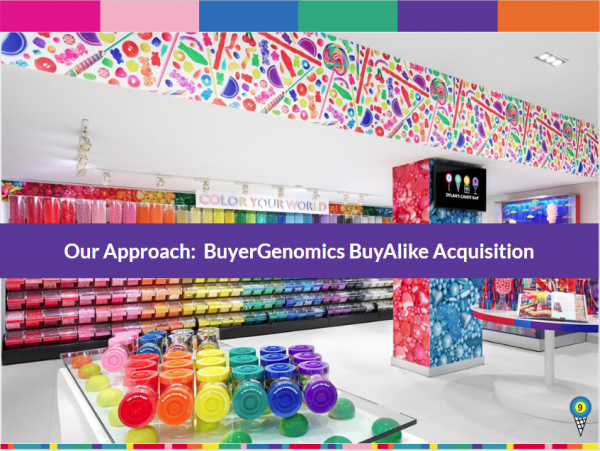 To move the brand and customer base forward, Dylan’s needed not just a new strategic approach, they needed a new high value customer.
Specifically, one that spent like the small cohort of their base did. Historically, they felt this exclusive customer type could only be found on the uber-affluent, upper west side of Manhattan, and couldn’t be reproduced readily anywhere else. If that were the case, Dylan’s would have a structural problem.
To move the brand and customer base forward, Dylan’s needed not just a new strategic approach, they needed a new high value customer.
Specifically, one that spent like the small cohort of their base did. Historically, they felt this exclusive customer type could only be found on the uber-affluent, upper west side of Manhattan, and couldn’t be reproduced readily anywhere else. If that were the case, Dylan’s would have a structural problem.
BuyerGenomics’ Strategy
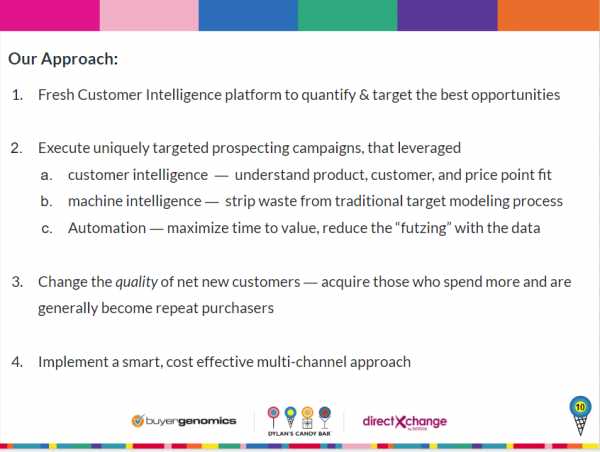 BuyerGenomics curated a simple approach to help Dylan’s:
BuyerGenomics curated a simple approach to help Dylan’s:
- Launch a customer intelligence platform on BuyerGenomics to rapidly enable the accurate quantification and targeting of high-value opportunities.
- Launch a targeted prospecting campaign that utilized the most advanced forms of customer intelligence, machine intelligence, and automation.
- Shift the mix of net new customers to those who spend more and are more likely to become repeat customers.
- Implement a multi-channel approach.
Our Methodology: The 70, 20, 10 Axiom
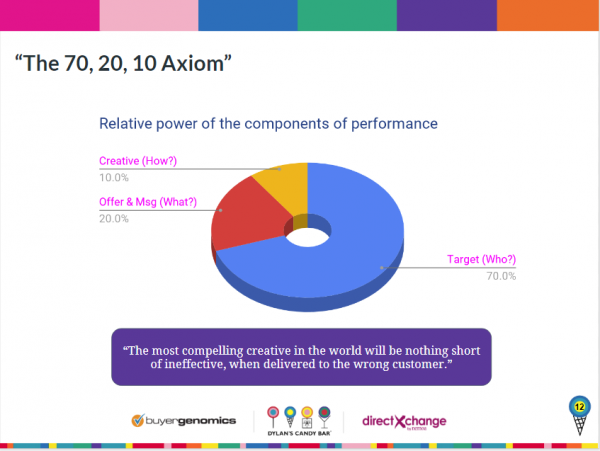 A tried and true axiom that guided BuyerGenomics’ approach at Dylan’s was a long used formula for success – the “70/20/10” – which still works every time.
A tried and true axiom that guided BuyerGenomics’ approach at Dylan’s was a long used formula for success – the “70/20/10” – which still works every time.
“70% of the marketers success comes from getting the target right, 20% of success comes from getting the offer right, and 10% comes from getting the creative right.”While Dylan’s consistently had the creative right, as an exceptionally creative brand experience is core to the business… but this one 1 out of 3..” You could have the best creative in the world, but it is ultimately ineffective when delivered to the wrong customer. These are the ones who lack the means, motivation, and means to shop, repeat purchase, and grow in loyalty and value. While its possible there are edge cases where the the creative alone may carry the day, on balance, if you had to market with only one of these dimensions – the target will outperform every single time.
Rapidly Produce Highly Actionable Customer Intelligence
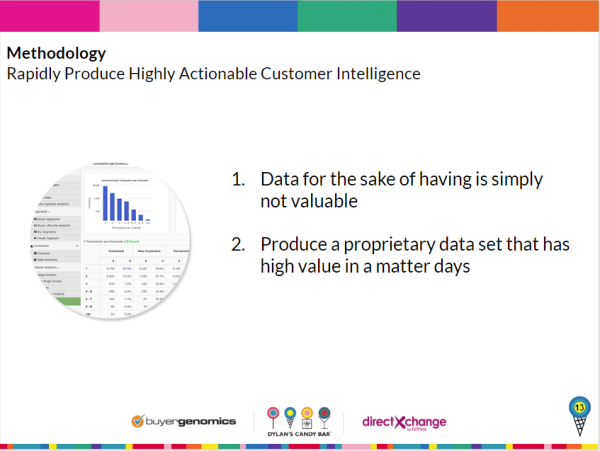 Cohen then discussed Dylan’s Customer Intelligence Platform.
Here are a few facts he shared:
Cohen then discussed Dylan’s Customer Intelligence Platform.
Here are a few facts he shared:
- The range of available intelligence and insights we have available is truly astounding, relative to all previous experience. We know exactly who our MVB really is, and we don’t rely on anecdotal narratives like we used to.
- Cohen provided examples of demographics, psychographics, lifestyles, purchasing behaviors, channel behaviors, predictive analytics, and much more.
- Who is the customer?
- How should we talk to them?
- How to engage them over time?
- How to avoid stagnation and increase repeat purchases? (Today, 1-time buyers make up the bulk of customers)
- How to build the direct to consumer relationship?
- How to drive in-store retail traffic?
Rapidly Create Actionable Loyalty Measures
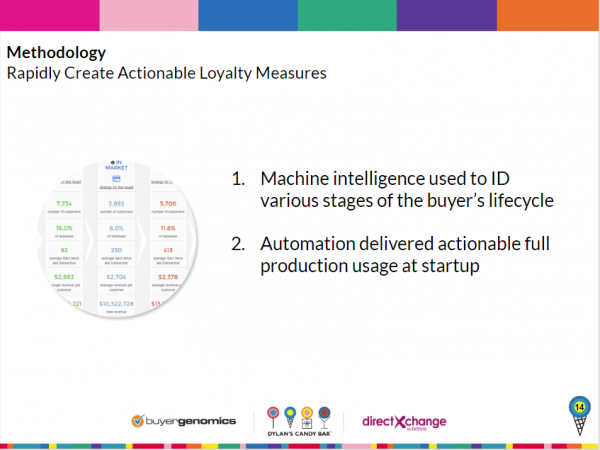 Customer purchase patterns were identified by automated algorithms that leveraged the wealth of available historical data. Meanwhile, the Buyer Lifecycle (BLC) engine tracked customer shifts along its six stages to track shifts in engagement and value.
Full production usage was available upon startup. And, moving forward, we captured every detectable customer interaction – allowing the machine intelligence to get smarter over time.
Customer purchase patterns were identified by automated algorithms that leveraged the wealth of available historical data. Meanwhile, the Buyer Lifecycle (BLC) engine tracked customer shifts along its six stages to track shifts in engagement and value.
Full production usage was available upon startup. And, moving forward, we captured every detectable customer interaction – allowing the machine intelligence to get smarter over time.
Discern What Makes the Customers More or Less Homogeneous
 By autonomously linking Personally Identifiable Information (PII) to third party data, our target became crystal clear – almost immediately.
We informed our messaging based on who we were really talking to, and they responded in kind.
We also utilized test & roll and automated intelligence in order to fine tune communications and maximize each customer’s value.
By autonomously linking Personally Identifiable Information (PII) to third party data, our target became crystal clear – almost immediately.
We informed our messaging based on who we were really talking to, and they responded in kind.
We also utilized test & roll and automated intelligence in order to fine tune communications and maximize each customer’s value.
Move From Initial Data Capture to “Buy-A-Like” Acquisition in Three Weeks
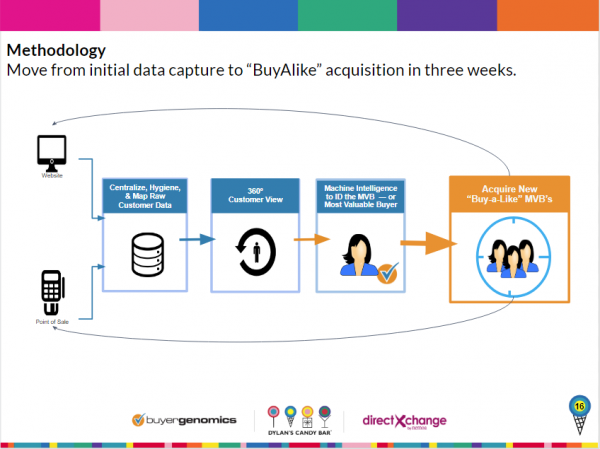 The capability gave Dylan’s a comprehensive portrait of its customers. This was unlike anything they had ever been able to achieve before.
The next question was: Now that we know who our customers are, how do we acquire more high-value ones?
The answer is simple. Ferranti and Cohen mapped out the BuyerGenomics methodology they used:
The capability gave Dylan’s a comprehensive portrait of its customers. This was unlike anything they had ever been able to achieve before.
The next question was: Now that we know who our customers are, how do we acquire more high-value ones?
The answer is simple. Ferranti and Cohen mapped out the BuyerGenomics methodology they used:
- Centralize online and offline data.
- Create a 360 degree view of the customer.
- Perform optimal target intelligence to define the MVB.
- Match the target with Buy-A-like targeting to acquire high potential new customers.
Buy-A-Like Targeting
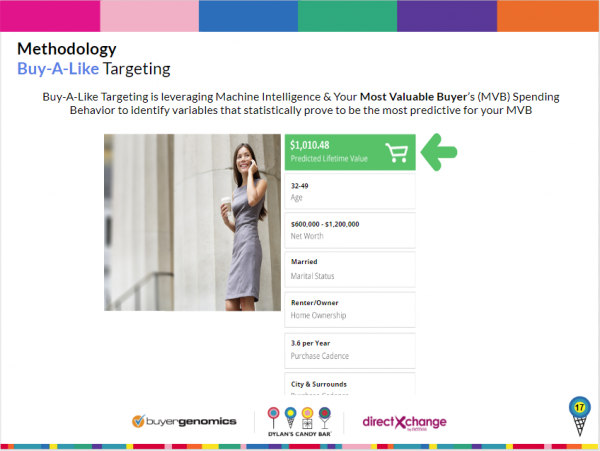 By knowing exactly what their high-value customers looked like, we leveraged adaptive algorithms that executed buy-a-like targeting in a fraction of the time traditional approaches do.
Machine intelligence leverages 850 Demographic, Psychographic, and Lifestyle variables to create a Full 360-Degree Customer View.
This literally develops millions of potential models and validates those that select actual MVB’s from Dylan’s customer database automatically. The highest performer from back testing is the one used to run campaigns with.
Also, the BuyerGenomics target was shared with the social media agency for doing look alike modeling on Facebook and Google Display. The results of this kind of targeting are also dramatically better than the prior targeting used.
Therefore, we saved an incredible amount of time and resources by diving in and knowing who the MVBs are, as well as where (and how) to reach them.
By knowing exactly what their high-value customers looked like, we leveraged adaptive algorithms that executed buy-a-like targeting in a fraction of the time traditional approaches do.
Machine intelligence leverages 850 Demographic, Psychographic, and Lifestyle variables to create a Full 360-Degree Customer View.
This literally develops millions of potential models and validates those that select actual MVB’s from Dylan’s customer database automatically. The highest performer from back testing is the one used to run campaigns with.
Also, the BuyerGenomics target was shared with the social media agency for doing look alike modeling on Facebook and Google Display. The results of this kind of targeting are also dramatically better than the prior targeting used.
Therefore, we saved an incredible amount of time and resources by diving in and knowing who the MVBs are, as well as where (and how) to reach them.
Buy-A-Like Targeting (Cont’d)
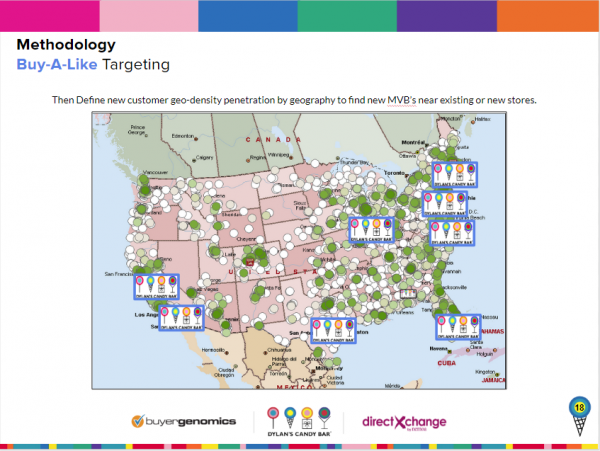 For a multi-channel brand like Dylan’s, driving in-store traffic was key.
BuyerGenomics used Geo-Density Targeting around retail locations in order to drive in-store traffic based on drive time, on top of all of our other available information.
For a multi-channel brand like Dylan’s, driving in-store traffic was key.
BuyerGenomics used Geo-Density Targeting around retail locations in order to drive in-store traffic based on drive time, on top of all of our other available information.
The Solution: Omnichannel Campaigns “Surround” Buy-A-Like Prospects
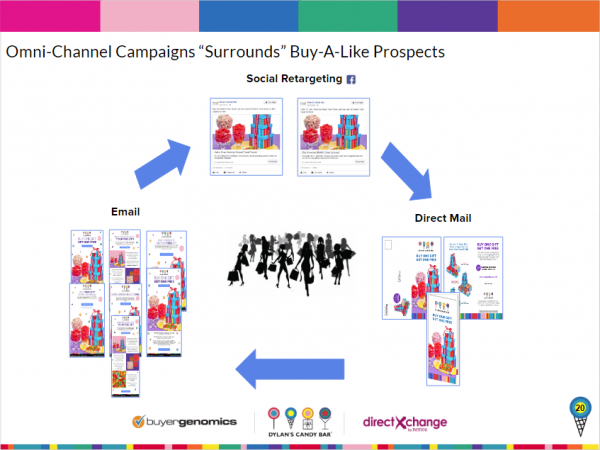 Commencing with the expectation of an omni-channel program, we implemented a multi-step email, direct mail, and social media campaigns.
By doing this, we effectively \”surrounded\” the prospect by direct mailing the openers of email campaigns and retargeting display ads – in addition to email as well.
Commencing with the expectation of an omni-channel program, we implemented a multi-step email, direct mail, and social media campaigns.
By doing this, we effectively \”surrounded\” the prospect by direct mailing the openers of email campaigns and retargeting display ads – in addition to email as well.
Omnichannel Campaigning – Drive Response and Understand Motivations for Responders & Converters
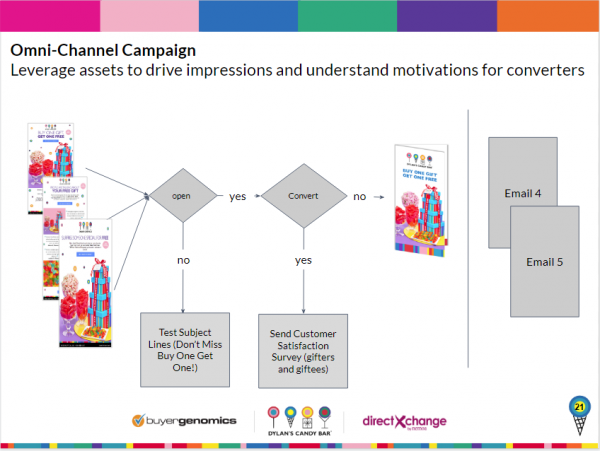 Our email campaign followed a logical campaign flow that involved using testing and learning to determine the best creatives that led buyers along the funnel to make a purchase.
Our email campaign followed a logical campaign flow that involved using testing and learning to determine the best creatives that led buyers along the funnel to make a purchase.
Design Direct Mail Creatives [That Worked]
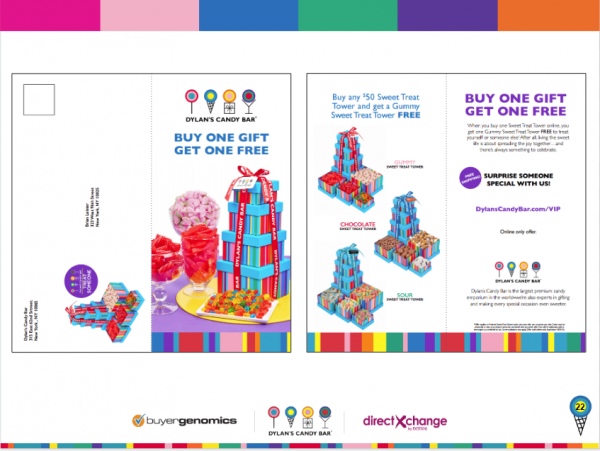 Cohen shared the direct mail pieces we used, featuring a Buy One, Get One offer that worked best at teasing high potential buyers into a trial purchase.
Cohen shared the direct mail pieces we used, featuring a Buy One, Get One offer that worked best at teasing high potential buyers into a trial purchase.
The Results: Sweet Success

The Numbers Behind Dylan’s Scaling of Profitable Customer Acquisition
 The results were not just eye-opening for Dylan’s, they were astounding.
The results were not just eye-opening for Dylan’s, they were astounding.
- 145% of New “Most Valuable Buyers” acquired vs. Goal.
- Over 225% Conversion Improvement (on 30% of Investment).
- Over 50% Increase in Average Spend.
- Over 63% Increase in Repeat Purchase Rate.
How Dylan’s Can Scale Up High Value Customer Acquisition
 BuyerGenomics’ simulation forecasted an incredibly positive future state, with more of Dylan’s customers adopting them as a lifestyle brand:
They included an approximate 800% increase.
The simulation was based on solid evidence — just 1.3% of Dylan’s new customers historically ever became were 2+ Buyers. The rest were one-time, “tourist” buyers.
Afterwards, that number of 2+ buyers skyrocketed to 15%
BuyerGenomics’ simulation forecasted an incredibly positive future state, with more of Dylan’s customers adopting them as a lifestyle brand:
They included an approximate 800% increase.
The simulation was based on solid evidence — just 1.3% of Dylan’s new customers historically ever became were 2+ Buyers. The rest were one-time, “tourist” buyers.
Afterwards, that number of 2+ buyers skyrocketed to 15%
How Dylan’s is Scaling Profitable Customer Acquisition
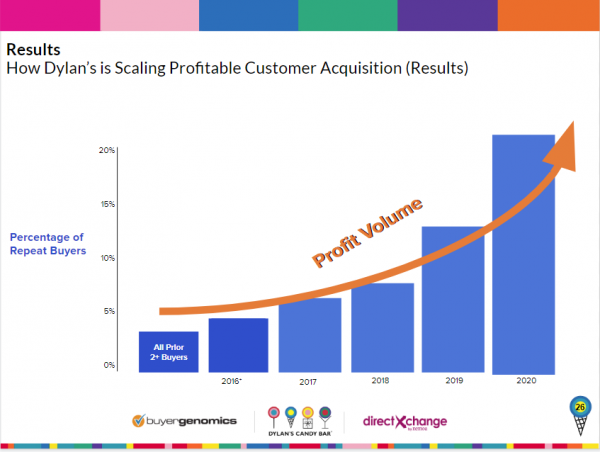 Through superior Customer Intelligence, optimal target definition, and methodical acquisition strategy, the MVBs acquired during Dylan’s campaigns (customers who make a second and third purchases within 12 months) are now projected to grow substantially over time.
Additionally, profitability scales up with higher-value customer acquisition, since customers that keep spending are customers that generate more profits sooner relative to their acquisition cost.
Dylan’s also found the rate of moving from the first to second purchase was materially faster than Dylan’s average In-Market buyer — one who was expected to make a purchase in the near term.
In other words, this strategy effectively produced unique, prime buyers.
Through superior Customer Intelligence, optimal target definition, and methodical acquisition strategy, the MVBs acquired during Dylan’s campaigns (customers who make a second and third purchases within 12 months) are now projected to grow substantially over time.
Additionally, profitability scales up with higher-value customer acquisition, since customers that keep spending are customers that generate more profits sooner relative to their acquisition cost.
Dylan’s also found the rate of moving from the first to second purchase was materially faster than Dylan’s average In-Market buyer — one who was expected to make a purchase in the near term.
In other words, this strategy effectively produced unique, prime buyers.
The Future: Just Desserts
 So, what did the future hold for Dylan’s, and what were the next steps?
So, what did the future hold for Dylan’s, and what were the next steps?
Next Steps: Autonomously Grow Lifetime Value and Profit with Machine Intelligence
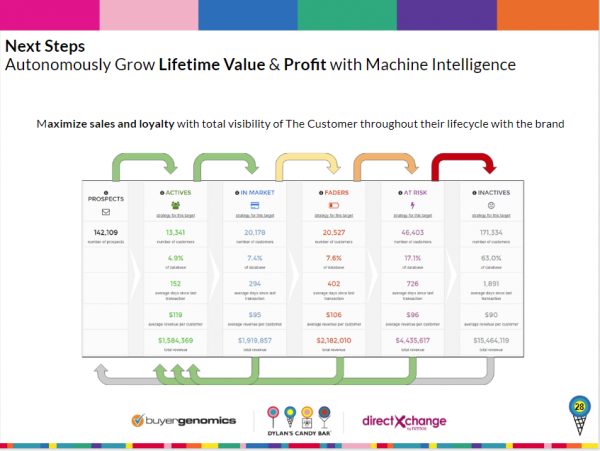 The next steps we aligned on were to manage the aforementioned Buyer Lifecycle of their customers while maximizing their Lifetime Value [LTV]
The above slide illustrates BuyerLifecycle in BuyerGenomics and the flow of customers from one lifecycle state to the next.
The “BLC” details the natural evolution of a customer/retailer relationship – depicting your customer’s relationship and brand engagement from the moment that they become a prospect, to an in-market buyer, and finally inactive.
BuyerGenomics PMA software utilizes email behaviors, past purchases, web behaviors and external data sources to understand how engaged and likely to purchase again individual customers are at any given point in time. Each individual’s Lifecycle Stage is re-assessed daily to take into consideration all of the touches and changes the BLC can observe.
These are the six steps through which BuyerGenomics classifies customers and tailors its messaging accordingly:
The next steps we aligned on were to manage the aforementioned Buyer Lifecycle of their customers while maximizing their Lifetime Value [LTV]
The above slide illustrates BuyerLifecycle in BuyerGenomics and the flow of customers from one lifecycle state to the next.
The “BLC” details the natural evolution of a customer/retailer relationship – depicting your customer’s relationship and brand engagement from the moment that they become a prospect, to an in-market buyer, and finally inactive.
BuyerGenomics PMA software utilizes email behaviors, past purchases, web behaviors and external data sources to understand how engaged and likely to purchase again individual customers are at any given point in time. Each individual’s Lifecycle Stage is re-assessed daily to take into consideration all of the touches and changes the BLC can observe.
These are the six steps through which BuyerGenomics classifies customers and tailors its messaging accordingly:
- Prospects – Not yet customers, signed up for an email newsletter, etc.
- Actives – Individuals currently engaged and/or spending with you.
- In Market – Buyers currently shopping for your products and are prepared/likely to buy again.
- Faders – Subjects no longer purchasing at the rate their customer profile suggests they can.
- At Risk – Buyers most likely to stop spending with your brand and fall into attrition.
- Inactives – Customers who have ceased purchasing your products.
Conclusions
Dylan’s Candy Bar continues to grow as a vibrant business and marketer, and BuyerGenomics continues to support Dylan’s large customer base in their pursuit of the acquisition and growth of high potential customers. Meanwhile, BuyerGenomics PMA customer intelligence is constantly updated to keep progress on track and growing.Want to learn more? See how BuyerGenomics’ premier Predictive Marketing Automation capabilities can help drive results like these for your business. Schedule a demo and we’ll be happy to show you!





